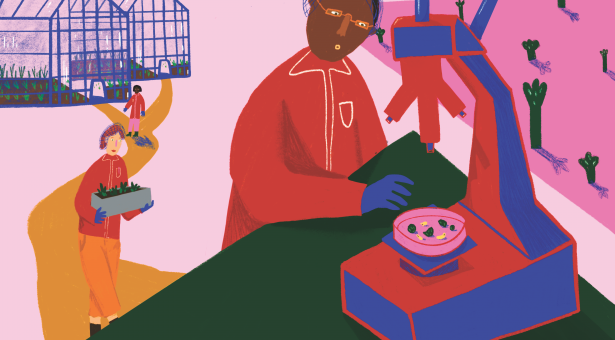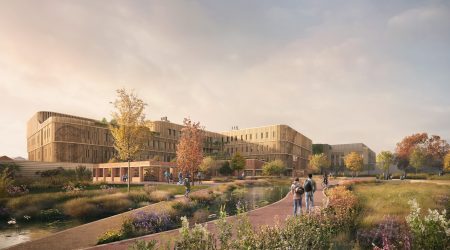Art and illustration inspired by plant and microbial science

Norwich is home to both world-renowned scientific research and a thriving arts scene and we’re delighted that our research has been, and continues to be, used as inspiration and reference for many diverse art and illustration projects.
For thousands of years humans have been inspired by the natural world. Our historic collections and archives hold botanical illustrations centuries old, that were crucial in developing early understanding of nature, genetics and were part of the foundation of modern scientific research.
More recently, in 2019, we began a collaboration with illustration tutors and students at the Norwich University of the Arts to explore illustration as a way of communicating sometimes dense, challenging and complex science in a digestible and engaging way.
To begin the project, second year illustration students came to explore our labs and greenhouses. The students were given the opportunity to meet early career researchers here at the John Innes Centre, along with those at our fellow Norwich Research Park institute; The Sainsbury Laboratory. This introduction gave them a chance to learn about concepts in the world of plant and microbial science.
After eight weeks of research and developing their ideas the students produced an exhibition. Placed in a gallery in the centre of Norwich their creative and innovative illustrations of plant and microbial science attracted new audiences to our research.
Work ranged from children’s books about developments in wheat genetics, through to raincoats representing plants defence against disease.
Science presented in this way was not only used in some of our communication work, but also changed the illustration students’ perceptions of science. “At school I didn’t like science, I found it difficult, but I’ve loved learning about science in this way” remarked illustration student Yasmina Bunjo.
The benefits of the collaboration were also felt back in the lab.
Seeing their work through someone else’s eyes, can prompt scientists to think about their research from different perspectives. As Kelly Robinson from the Sainsbury lab explains; “It was a great experience, and the student’s imaginative approaches has provoked new ideas.”
Through initiatives like this, and the SAW Trust things are changing from when Yasmina first encountered science at school. The Science, Art and Writing Trust was founded by Professor Anne Osbourn and uses science creatively in the classroom to inspire artistic and scientific endeavour. They also have an online collection of scientific imagery and have recently run an art and poetry competition for work inspired by this imagery.
Some of our scientists produce artwork too, for example Professor Rico Coen paints portraits of visiting guest lecturers while technician Tobin Florio produces scientific illustrations for published papers.
Along with organisation collaborations and initiatives we have been delighted for our research to provide inspiration for practising illustrators curious about plants and microbes.
Ephemeral magazine, a new independent illustration magazine, inspired by the ephemerality of the model plant Arabidopsis thaliana decided to theme their latest issue around plant science. The magazine, available to buy across Europe, featured our work on speed breeding and plant-based vaccines after visiting our researchers Dr Brande Wulff and Roger Castells Graells.
Following this we have used work by illustrator Louise Fitzgerald, whose illustrations featuring in Ephemeral Magazine and is a graduate from NUA, in our public engagement work to communicate our research on legumes to audiences at British Science Festival and beyond.
It’s not just illustrators who have taken inspiration from our plant and microbial research. Fine artists and textile artists have too.
In 2017 we hosted an artist-in-residence Malca Schotten for the ‘Lives in Science’ project, which features five our research groups and remains on display in Centrum on the Norwich Research Park.
Recently in 2020, an exciting recent project by digital artist Henry Driver has used imagery from Dr Myriam Charpentier and Dr Cat Jacott to produce a permanent artwork at Cressing Temple Barns in Essex. Henry has shown work internationally including Tate Britain. This permanent artwork is free and open to the public.
Caroline Hyde-Brown, a postgraduate NUA textile student has also visited the Norwich Research Park for her work which uses roots and straw leftover from our work on Grass pea to weave materials.
If you are an illustrator, poet, writer or artist interested in finding out more about working with us get in touch by emailing Ruby.OGrady@jic.ac.uk or info@sawtrust.org
Image credit: Louise Fitzgerald

